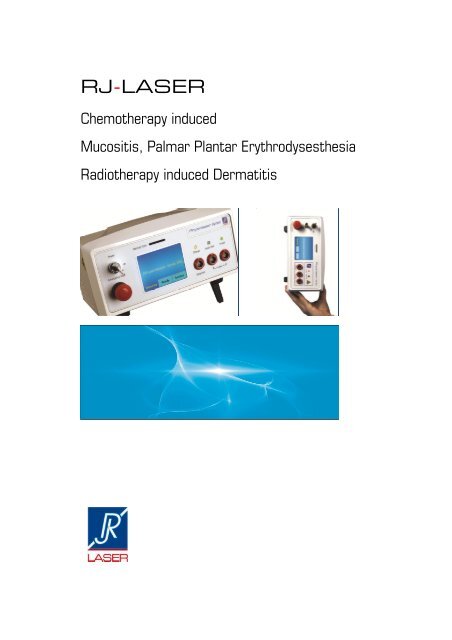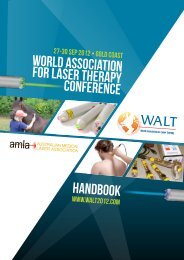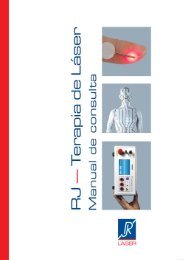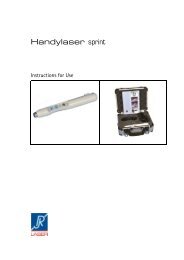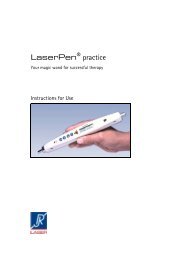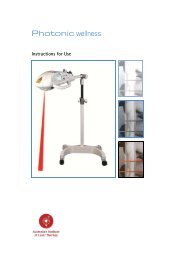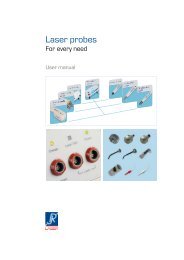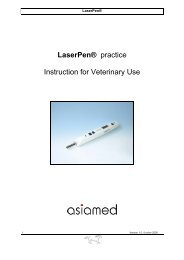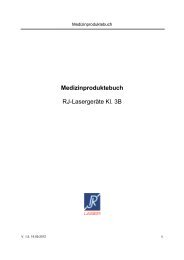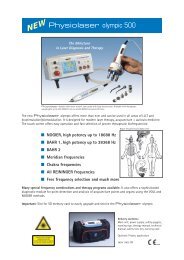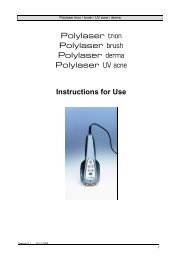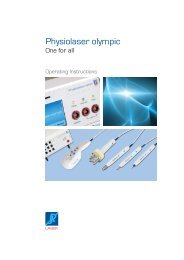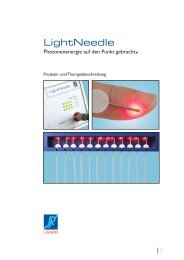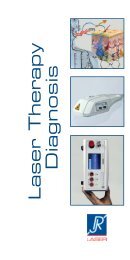General - RJ-Laser
General - RJ-Laser
General - RJ-Laser
You also want an ePaper? Increase the reach of your titles
YUMPU automatically turns print PDFs into web optimized ePapers that Google loves.
<strong>RJ</strong>-LASER<br />
Chemotherapy induced<br />
Mucositis, Palmar Plantar Erythrodysesthesia<br />
Radiotherapy induced Dermatitis
<strong>RJ</strong>-LASER<br />
Recommendations for chemotherapy induced skin disorders<br />
<strong>General</strong><br />
Oral mucositis (OM) and other chemotherapy induced skin disorders as Palmar Plantar<br />
Erythrodysesthesia, dermatits are an inevitable complication of radiation therapy (RT), as part<br />
of gastrointestinal toxicity in chemotherapy and hematopoietic stem cell transplantation (HSCT),<br />
causing severe morbidity and affecting the patient’s quality of life.<br />
Palmar plantar erythrodysesthesia (PPE) is a toxicity that can occur to the palms of hands and<br />
soles of feet with specific chemotherapy treatments. PPE (also known as hand- foot syndrome)<br />
as a condition marked by pain, swelling, numbness, tingling, or redness of the hands or feet<br />
and defined as a cutaneous toxicity that manifests with palmar and plantar erythema, edema, ,<br />
scaling, and vesiculation. The incidence of PPE depends on the drug therapy, dosage, and the<br />
manner in which the drug is administered.<br />
Duration and severity of OM, especially in higher grades, are critical, as it hampers the cancer<br />
treatment, affects duration of hospital stay, and to a certain extent, predicts success of<br />
treatment and complications such as graft-versus-host disease (GVHD) in transplantation<br />
patients. There is no consensus on a single agent or agents that can be used either<br />
prophylactically or therapeutically in OM. The frequency of OM varies from 12% in patients<br />
receiving adjuvant chemotherapy to 80% and 100% in patients undergoing HSCT and RT of<br />
the orofacial region, respectively.1,2 The art and science of photomedicine, low-level laser<br />
therapy (LLLT) have become promising and effective tools in prophylactic and therapeutic<br />
interventions for OM, orofacial pain and PPE.<br />
Considerable buccal toxicity of radiotherapy and/or chemotherapy in patients with cancer can<br />
cause patients to become discouraged and can alter their quality of life. In addition, such<br />
toxicity often necessitates alterations of treatment planning, with grave consequences in term of<br />
tumor response and even survival (concept of dose-intensity).<br />
Photomedicine using LLLT is very effective with intra-oral and extra-oral devices in the<br />
management of OM, based on several reports including randomised control studies.<br />
Photomedicine is a safe and relatively inexpensive intervention for cancer therapy-induced<br />
OM. It is envisaged that Photomedicine will soon become part of routine oral supportive care<br />
in cancer.<br />
Multinational Association of Supportive Care in Cancer/International Society of Oral<br />
Oncology (MASCC/ISOO) guidelines of 2004 on cancer supportive care and management<br />
reported LLLT as a “possible option”. In 2007, MASCC-ISOO ‘evidence-based’ mucositis<br />
guidelines have upgraded LLLT as a "recommended" method for the prevention of OM during<br />
bone-marrow transplantation or HSCT. American Cancer Society mentioning the evidence<br />
behind LLLT as ‘promising’.<br />
<strong>Laser</strong> therapy can be used as a stand-alone therapy, as an adjunctive to common treatments<br />
and it can easily be combined with other therapies and medicaments.<br />
© <strong>RJ</strong>-LASER Germany | 1
<strong>RJ</strong>-LASER<br />
Recommendations for chemotherapy induced skin disorders<br />
Mucositis accurs in the following frequency:<br />
10% with adjuvant chemotherapy<br />
40% during chemotherapy (curative)<br />
80% stemcell transplantation (myeloablative chemotherapy)<br />
100% head and neck tumors and radiation therapy (head in the radiation field)<br />
Grades of mucositis according to the WHO<br />
0: normal oral mucosa, no visible changes<br />
I: erythema, soreness, burning of mucous membrane, no ulceration<br />
II: Erythema, small ulcers, receiving solid food is not restricted<br />
III: larger ulcers, the painful mouth allows only liquid/passed food<br />
IV: Essen und Trinken nicht mehr möglich<br />
Conventional therapies are limited<br />
The conventional treatment recommendation is poor, it is usually just limited to oral hygiene,<br />
pain management, vitamin intake etc.. There is no way to actively treat the condition of the<br />
mucosa (or skin in case of PPE) itself.<br />
The best therapeutic results in the laser therapy is achieved when the laser energy and power<br />
is in the biological optimum. The laser for biostimulation or biomodulation (LLLT) should heal<br />
and not destroy. The power, energy density, wavelength and duration of therapy (at the target<br />
tissue) play a vital role and shoulod be in the biological optimum<br />
.<br />
Additionally plays modulation (frequency / Hz) a role (so-called laser-resonance therapy).<br />
© <strong>RJ</strong>-LASER Germany | 2
<strong>RJ</strong>-LASER<br />
Recommendations for chemotherapy induced skin disorders<br />
For laser therapy the „biological law“ of Arndt/Schulz* is valid:<br />
strong stimulus paralyses/destroys<br />
intermediate stimulus blocks<br />
gentle stimulus improves<br />
The Arndt-Shultz Law summarizes experiments which measure the physiological response of a<br />
living organism to a stimulus. It says a small amount of a chemical or electrical or laser or other<br />
stimulus will increase physiological activity, a large amount of the same stimulus will kill cells of<br />
the organism, and an intermediate amount will inhibit physiological activity.<br />
The <strong>RJ</strong> laser devices are made for application to individual points, reflex therapy and for local<br />
treatment of small and large areas. <strong>RJ</strong> laser devices are used for:<br />
Local therapy (macro system)<br />
Reflexive therapy (micro system)<br />
Supply of photon energy (Joule)<br />
Transfer of information (Hz)<br />
Successful treatment requires the optimal:<br />
1. Probe<br />
2. Applicator head<br />
3. Wavelength<br />
4. Power<br />
5. Energy (J/cm 2 ) and exposure time<br />
6. Modulation frequency<br />
* The rule was named after Hugo Paul Friedrich Schulz and Rudolf Arndt. The latter originally formulated it in 1888.<br />
© <strong>RJ</strong>-LASER Germany | 3
<strong>RJ</strong>-LASER<br />
Recommendations for chemotherapy induced skin disorders<br />
How to reach the target tissue<br />
Depending on the individual conditions of the animal the laser beam can reach the target<br />
tissue or will be absorbed by color/pigmentation or particles.<br />
The mucosa is perfect to irradiate and the energy of the laser beam can easily reach the cells.<br />
Wavelength/power/energy<br />
<strong>RJ</strong> laser devices offer the recommended wavelengths for bio-modulation. The wavelengths of<br />
the <strong>RJ</strong> laser devices are in a very convenient “window” with low absorption levels which offer<br />
deep penetration. At higher ranges (1000 nm) absorption by water is greater and in lower<br />
ones, below 500 nm, absorption by red blood coloring and melanin is also more.<br />
Dispersion in the tissue<br />
The laser beam is dispersed among the different constituents in the tissue and is reflected. The<br />
main part of the beam penetrates directly.<br />
© <strong>RJ</strong>-LASER Germany | 4
<strong>RJ</strong>-LASER<br />
Recommendations for chemotherapy induced skin disorders<br />
Treatment duration and dosage (energy, J/cm 2 )<br />
The patient’s reaction and the symptom being treated should be used as guidelines. As soon as<br />
an improvement becomes apparent, therapy time can be adjusted and reduced gradually until<br />
final healing. The power between 150 -500 mW is proven to be optimal for bio-modulation,<br />
the risk of blocking because of overstimulation is low.<br />
Start with medium therapy duration<br />
The goal is to “charge” the cells with photon energy. If therapy is undertaken at high power<br />
intensity for too long, blockages could prevent the acceleration of the healing process.<br />
Note: It is better to saturate the cells with photon energy during long therapy duration than<br />
supplying the total energy within e.g. 2 seconds (as a “flash”). The biological cell system<br />
needs time to absorb the energy and react to the stimulus.<br />
Dosage, energy (Joule/cm 2 )<br />
The therapeutic dosage is calculated as energy or Joule per cm 2 . Within a certain time the<br />
required energy for cell stimulation is applied to the specified area/target (Joule/cm 2 ). Simply<br />
set the energy value in the submenu of your <strong>RJ</strong> laser.<br />
Follow the research<br />
Please pay attention to the results of scientific research which, of course, must be integrated<br />
into your therapy concept. <strong>General</strong>ly speaking a dosage of 4-6 Joule per cm 2 or 2-4 Joule per<br />
point is the recommended stimulus for laser therapy. Still the individual case and target tissue<br />
should be considered.<br />
© <strong>RJ</strong>-LASER Germany | 5
<strong>RJ</strong>-LASER<br />
Recommendations for chemotherapy induced skin disorders<br />
<strong>General</strong> treatment information (three levels)<br />
Level 1 – intra-oral, local direct<br />
Local irradiation, directly to the affected area<br />
inside the mouth is the most important step.<br />
The therapy shall lead to<br />
1. increase of e.g. ATP in the<br />
mitochondrials<br />
2. stimulation of the immune system<br />
3. reduction of pain<br />
4. acceleration of the regeneration<br />
5. reduction of inflammation.<br />
Level 2 - extra-oral, local indirect<br />
Additionally to level 1 the indirect irradiation<br />
outside of the mouth (cheeks), can be<br />
beneficial as well. It depends on the case,<br />
location and severity of the mucositis.<br />
Level 3 - reflective, systemic<br />
Recommendation additional to the<br />
direct/indirect local therapy:<br />
1. Irradiation of the arteria carotis or<br />
tongue, in order to get a systemic<br />
effect.<br />
2. Treatment of body/ear points related<br />
to the treatment area e.g. mouth.<br />
3. Treatment of reflex zones<br />
© <strong>RJ</strong>-LASER Germany | 6
<strong>RJ</strong>-LASER<br />
Recommendations for chemotherapy induced skin disorders<br />
Mucositis<br />
Palmar Planta Erythrodysesthesia (PPE)<br />
Condition <strong>General</strong> Dosage/cm2<br />
at the target<br />
Frequency<br />
Mucositis<br />
acute<br />
Mainly local therapy<br />
4-8 J local<br />
Daily<br />
A<br />
Probe<br />
Single cw<br />
Cluster cw<br />
Additional<br />
Ear points, Shen Men<br />
Chronic<br />
Local and reflexive<br />
therapy combined with<br />
basic treatment.<br />
6-10 J local<br />
3x/week<br />
B<br />
Single cw<br />
Cluster cw<br />
Extra-oral 10 J/cm 2<br />
Palmar Planta<br />
Erythrodysesthesia<br />
Dermatitis<br />
Irradiate directly above<br />
the damaged area of the<br />
skin.<br />
6-10 J local<br />
3x/week<br />
B, C<br />
Cluster cw<br />
Satellite<br />
scanner<br />
Ear points, Shen Men<br />
Recommendation: Wavelength for a red light source at 633–685 nm, infrared 780–<br />
810nm; output of diode between 100 - 500mW; dose in the range of 2–3 J/cm2 for<br />
prophylaxis, not less than 4-8 J/cm2 for therapeutic effect.<br />
© <strong>RJ</strong>-LASER Germany | 7
<strong>RJ</strong>-LASER<br />
Recommendations for chemotherapy induced skin disorders<br />
Modulation frequency<br />
<strong>RJ</strong> offers a large variety of bio-frequencies and ready Therapy Programs based on these<br />
frequencies. As an example, the NOGIER frequencies are commonly used since more than 30<br />
years for diagnosis and therapy. Below there is a brief summary of the NOGIER frequencies,<br />
which are displayed as: A´ B´ C´ D´ E´ F´ G´<br />
Frequency/Hz Disease, part of the body Acupuncture<br />
A’/292<br />
Acute illness, cellular level, inflammation, tumors<br />
Body orifices<br />
Shu point<br />
B’/584<br />
Chronic illness, metabolism, cell nutrition<br />
Abdomen<br />
Sedation<br />
C’/1168<br />
Circulation, energy transfer, motoric disorder,<br />
Bones, muscles, joints, extremities Tonification<br />
D’/2336<br />
Psychic disorders, fatigue, laterality disorders<br />
Commissures<br />
Alarm point<br />
E’/4672<br />
Nerve disturbances/pain, neuralgia, neuritides,<br />
Spinal cord, nerves<br />
Starting point<br />
F’/9344<br />
Depressions, psychic symptoms and causes,<br />
Bone reconstruction<br />
Face, subcortex, emotions<br />
End point<br />
G’/18688<br />
Intellectual and psychosomatic disturbances<br />
Frontal cerebral zone<br />
Source point<br />
Regenerating= A+B+F Analgesic= C+D+G, Muscle relaxation= E+G Focus= A´+A´´<br />
Apply the NOGIER frequencies directly on the body part and if possible according to the RAC<br />
pulse reaction. Always apply cw and the frequency additionally for a few<br />
seconds.<br />
© <strong>RJ</strong>-LASER Germany | 8
<strong>RJ</strong>-LASER<br />
Recommendations for chemotherapy induced skin disorders<br />
Ear points (for additional treatment)<br />
For mucositis: mouth (A), cheeks (F), Shen men<br />
For PPE/dermatitis: hand/feet (C), Shen men<br />
© <strong>RJ</strong>-LASER Germany | 9
<strong>RJ</strong>-LASER<br />
Recommendations for chemotherapy induced skin disorders<br />
Research<br />
The Prevention of Induced Oral Mucositis with Low-Level <strong>Laser</strong> Therapy in<br />
Bone Marrow Transplantation Patients: A Randomized Clinical Trial<br />
Geisa Badauy Lauria Silva, D.D.S., M.Sc.,1 Elismauro Francisco Mendonc¸a, D.D.S., M.Sc., Ph.D.,2<br />
Cesar Bariani, M.D.,1 Heliton Spindola Antunes, D.D.S., M.Sc.,3 and Maria Alves Garcia Silva, D.D.S., M.Sc., Ph.D.2<br />
Abstract<br />
Background Data and Objective: Patients who have received high doses of<br />
chemotherapy, either alone or in combination with total body irradiation often cite oral<br />
mucositis (OM) as the most debilitating side effect. The aim of this study was to investigate the<br />
clinical effects of low-level laser therapy (LLLT) on the prevention of conditioning-induced OM in<br />
hematopoietic stem cell transplantation (HSCT).<br />
Material and Methods: We randomized 42 patients who underwent autologous or<br />
allogeneic HSCT. A low-level InGaAlP diode laser was used, emitting light at 660 nm, 40mW,<br />
and 4 J/cm2. An evaluation of OM was carried out using the World Health Organization<br />
scale. Results and Conclusion: In the LLLT group, 57.1% of patients had an OM grade 0, 9.6%<br />
had grade 1, and 33.3% had grade 2, whereas in the control group, only 4.8% of patients<br />
were free of OM (grade 0).<br />
Results: Our results indicate that the preventive use of LLLT in patients who have undergone<br />
HSCT is a powerful instrument in reducing OM incidence.<br />
Severity of Oral Mucositis in Patients Undergoing Hematopoietic Cell<br />
Transplantation and an Oral <strong>Laser</strong> Phototherapy Protocol: A Survey of 30<br />
Patients<br />
Fernanda de Paula Eduardo, D.D.S., M.S.D., Ph.D.,1 Leticia Bezinelli, D.D.S.,1<br />
Ana Claudia Luiz, D.D.S., M.S.D.,1 Luciana Correa, D.D.S., M.S.D., Ph.D.,2<br />
Cristina Vogel, R.N.,1 and Carlos de Paula Eduardo, D.D.S., M.S.D., Ph.D.3<br />
Abstract<br />
Background Data and Objective: Oral mucositis (OM) is one of the worst cytotoxic<br />
effects of chemotherapy and radiotherapy in patients undergoing hematopoietic cell<br />
transplantation (HCT), and it causes severe morbidity.<br />
<strong>Laser</strong> phototherapy has been considered as an alternative therapy for prevention and<br />
treatment of OM. The aim of this study was to describe the incidence and severity of OM in<br />
HCT patients subjected to laser phototherapy, and to discuss its effect on the oral mucosa.<br />
Patients and Methods: Information concerning patient age and gender, type of basic<br />
disease, conditioning regimen, type of transplant, absence or presence of pain related to the<br />
oral cavity, OM grade, and adverse reactions or unusual events were collected from 30<br />
patients undergoing HCT (allogeneic or autologous). These patients were given oral laser<br />
© <strong>RJ</strong>-LASER Germany | 10
<strong>RJ</strong>-LASER<br />
Recommendations for chemotherapy induced skin disorders<br />
phototherapy with a InGaAIP laser (660 nm and 40 mW) daily. The data were tabulated and<br />
their frequency expressed as percentages.<br />
Results: In the analysis of those with OM, it was observed that 33.4% exhibited grade I,<br />
40% grade II, 23.3% grade III, and 3.3% grade IV disease. On the most critical post-HCT<br />
days (D_5 and D_8), it was observed that 63.3% of patients had grade I and 33.3% had<br />
grade II disease; no patients had grade III or IV disease in this period. This severity of OM was<br />
similar to that seen in other studies of laser phototherapy and OM.<br />
Conclusion: The low grades of OM observed in this survey show the beneficial effects of<br />
laser phototherapy, but randomized clinical trials are necessary to confirm these findings.<br />
Photomedicine and <strong>Laser</strong> Surgery<br />
Vue 27 uber 1 2009<br />
Low Level <strong>Laser</strong> Therapy in Management of Chemotherapy-<br />
Induced Oral Mucositis: Prophylaxis or Treatment<br />
Gholamreza Esmaeeli Djavid1, Amirhossein Emami2, Leila Ataie-Fashtami3<br />
Seyed reza Safaeinodehi2, Farzad Merikh-Baiat4, Mohsen Fateh1, Nasrin Zand3<br />
1Photobiostimulation Research Group, Iranian Center for Medical <strong>Laser</strong>, Academic Center for Education, Culture, and<br />
Research (ACECR), Tehran, Iran<br />
2Assistant Professor of Hematology and Oncology, Valiasr Hospital, Tehran University of Medical Sciences, Tehran, Iran<br />
3Assistant Professor of Dermatology, Iranian Center for Medical <strong>Laser</strong>, Academic Center for Education, Culture, and<br />
Research (ACECR), Tehran, Iran<br />
4Researcher, Tehran University of Medical Sciences, Tehran, Iran<br />
Abstract:<br />
Introduction: Chemotherapy-induced oral mucositis (COM) is a common, debilitating<br />
complication of cancer therapy. The aims of this study were to evaluate the effect of<br />
low level laser therapy (LLLT) on prevention of COM in patients with hematologic<br />
malignancies.<br />
Methods: Fifty-five patients hospitalized to undergo chemotherapy in Imam Hospital<br />
were included into the study. These patients were divided into two groups. The oral<br />
cavity of the patients were illuminated by continues laser beam using a GaAlAs<br />
laser device with wavelength of 630 nm, power output 30 mW, and dose of 5 J/cm2<br />
for six days (LLLT group). The patients in the second group underwent placebo<br />
irradiation (power output equal to zero) with the similar protocol. The severity of<br />
the COM was clinically evaluated based on WHO grading scale. The patientys’<br />
quality of life was assessed before and after the intervention according to EORTC<br />
QLQ-C30 questionnaire.<br />
Results: The incidence of COM in LLLT group (31%) was less than the placebo<br />
group (41%). Mean duration of COM healing was 4.8 and 12 days in LLLT and<br />
placebo groups, respectively (p=0.03). Xereostomia was significantly less severe in<br />
LLLT group in comparison with the placebo group (p=0.007).<br />
Conclusion: Our findings showed that LLLT significantly reduced the incidence of<br />
oral mucositis of WHO grade 3 and 4 as the most debilitating form of oral mucositis,<br />
in which oral alimentation is impossible. Also, LLLT could reduce duration of oral<br />
mucositis, decreased the risk of secondary infection, and accelerated return to normal<br />
nutrition.<br />
© <strong>RJ</strong>-LASER Germany | 11
<strong>RJ</strong>-LASER<br />
Recommendations for chemotherapy induced skin disorders<br />
Use of 660-nm Diode <strong>Laser</strong> in the Prevention and Treatment of Human Oral<br />
Mucositis Induced by Radiotherapy and Chemotherapy<br />
Taı´s Zanin, D.D.S., M.S.,1,2 Fatima Zanin, D.D.S., M.S., Ph.D.,3 Artur Aburad Carvalhosa, D.D.S., Ph.D.,2<br />
Paulo Henrique de Souza Castro, D.D.S.,2 Marcos Tadeu Pacheco, Ph.D.,3<br />
Iriana Carla Junqueira Zanin, D.D.S., M.S., Ph.D.,4 and Aldo Brugnera Junior, D.D.S., M.S., Ph.D.3<br />
Abstract<br />
Objective: The aim of this multidisciplinary study was to evaluate quantitatively and<br />
qualitatively the effect of a 660-nm diode laser in the prevention and treatment of human oral<br />
mucositis (OM) in patients suffering from head and neck cancer who had undergone<br />
radiotherapy and chemotherapy.<br />
Background Data: OM is a severe oral lesion resulting from the toxic effects of treatment<br />
for cancer in the head and neck region. Low-level laser therapy is indicated to prevent and<br />
treat this oral complication and may be used alone or in association with conventional drug<br />
treatment, producing pain relief and wound repair.<br />
Methods: This study included 72 patients with head and neck cancer treated at the Cancer<br />
Hospital of Mato-Grosso, Brazil, and divided into a control group (C; n¼36) and a laser<br />
group (L; n¼36). <strong>Laser</strong> therapy was performed in combination with radiotherapy<br />
and chemotherapy twice a week using a diode laser (l¼660 nm, power¼30mW, spot<br />
size¼2 mm, energy¼2 J per point).<br />
Results: Statistically significant differences were observed between the two groups. Patients in<br />
group L usually did not present with OM or pain, but all patients in group C presented with<br />
OM ranging from Level I to III associated with pain. This difference was significant from week<br />
1 on, increased until week 4 and remained stable up to week 7. Conclusion: <strong>Laser</strong> therapy<br />
was effective in preventing and treating oral effects induced by radiotherapy and<br />
chemotherapy, thus improving the patient’s quality of life.<br />
Photomedicine and <strong>Laser</strong> Surgery<br />
Volume 28, Number 2, 2010<br />
The Prevention of Induced Oral Mucositis with Low-Level <strong>Laser</strong> Therapy in<br />
Bone Marrow Transplantation Patients: A Randomized Clinical Trial<br />
Geisa Badauy Lauria Silva, D.D.S., M.Sc.,1 Elismauro Francisco Mendonc¸a, D.D.S., M.Sc., Ph.D.,2<br />
Cesar Bariani, M.D.,1 Heliton Spindola Antunes, D.D.S., M.Sc.,3 and Maria Alves Garcia Silva, D.D.S., M.Sc., Ph.D.2<br />
Abstract<br />
Background Data and Objective: Patients who have received high doses of<br />
chemotherapy, either alone or in combination with total body irradiation often cite oral<br />
mucositis (OM) as the most debilitating side effect. The aim of this study was to investigate the<br />
clinical effects of low-level laser therapy (LLLT) on the prevention of conditioning-induced OM in<br />
hematopoietic stem cell transplantation (HSCT).<br />
Methods: We randomized 42 patients who underwent autologous or allogeneic HSCT. A<br />
low-level InGaAlP diode laser was used, emitting light at 660 nm, 40mW, and 4 J/cm2. An<br />
evaluation of OM was carried out using the World Health Organization scale. Results and<br />
© <strong>RJ</strong>-LASER Germany | 12
<strong>RJ</strong>-LASER<br />
Recommendations for chemotherapy induced skin disorders<br />
Conclusion: In the LLLT group, 57.1% of patients had an OM grade 0, 9.6% had grade 1,<br />
and 33.3% had grade 2, whereas in the control group, only 4.8% of patients were free of<br />
OM (grade 0).<br />
Results: Our results indicate that the preventive use of LLLT in patients who have undergone<br />
HSCT is a powerful instrument in reducing OM incidence.<br />
Photomedicine and <strong>Laser</strong> Surgery<br />
Volume 29, Number 1, 2011<br />
LEVEL LASER THERAPY IN TRE PREVENTION AND MANAGEMENT OF ORAL<br />
MUCOSITIS INDUCED BY CANCER TREATMENTS: EVIDENCE-BASED DATA FROM<br />
RANDOMIZED STUDIES AND META-ANALYSES<br />
René-Jean Bensadoun, M.D.<br />
Professor and Chairman, Radiation Oncology Department, CHU de Poitiers<br />
Address: BP 577, 86021 - Poitiers Cedex, France , E-mail: rene-jean.bensadoun@chu-poitiers.fr<br />
ABSTRACT<br />
We discuss the promising state of the art of Photomedicine for preventative and therapeutic<br />
usage in Oral Mucositis (OM) due to cancer therapy.<br />
Recent findings: Photomedicine using LLLT or LED is very effective with intra-oral and extraoral<br />
devices in the management of OM, based on several reports including randomised control<br />
studies. A systematic review identified 33 relevant articles which were subjected to metaanalysis<br />
based on which laser parameters in routine practice are being defined. Meta-analysis<br />
showed that LLLT reduced risk of OM with relative risk (RR) 2.45 (CI 1.85-3.18), reduced<br />
duration, severity of OM and reduced number of days with OM (4.38 days, p=0.0009).<br />
Relative risk was similar between the red (630-670 nm) and infrared (780-830 nm) LLLT. Painrelieving<br />
effect based on the Cohen scale was at 1.22 (CI 0.19-2,25).<br />
Conclusion: There is moderate to strong evidence in favour of Photomedicine at optimal<br />
doses as a safe, relatively inexpensive intervention for cancer therapy-induced OM. It is<br />
envisaged that Photomedicine will soon become part of routine oral supportive care in cancer.<br />
<strong>Laser</strong> in medicine, vol I, issue 1, October 2012<br />
PPE<br />
Objective: The aim of this study was to evaluate the usefulness of low-level laser therapy (LLLT)<br />
for the control of painful stomatitis in patients with hand-foot-and-mouth disease (HFMD).<br />
Background Data: LLLT has been successfully applied to various painful oral mucosal<br />
diseases, although there have been few reports on LLLT for HFMD patients.<br />
Material and Methods: Through a randomized double-blind placebo controlled trial, the<br />
painful period of HFMD stomatitis was compared between the LLLT group (n=11) and the<br />
placebo LLLT one (n=9), which had similar clinical backgrounds. The LLLT parameters supplied<br />
© <strong>RJ</strong>-LASER Germany | 13
<strong>RJ</strong>-LASER<br />
Recommendations for chemotherapy induced skin disorders<br />
were as follows: wavelength of 830 nm, power of 30 mW, frequency of 30 Hz, and energy<br />
output of 1.1 J/cm2. Acceptability and safety of the treatment were also evaluated.<br />
Results: The painful period was shorter in the LLLT group (4.0 +/- 1.3 days) than in the<br />
placebo LLLT one (6.7 +/- 1.6 days) with a statistically significant difference (p
<strong>RJ</strong>-LASER<br />
Recommendations for chemotherapy induced skin disorders<br />
Recommended probes<br />
Probe type<br />
Application Specification<br />
Points small<br />
areas<br />
Single probe cw<br />
150 mW/638 nm (used for PDT as well)<br />
2 Joule/13 sec.<br />
500 mW/810 nm/2 Joule/4 sec.<br />
Points small<br />
areas<br />
Dark hair/skin<br />
Deep bone<br />
penetration<br />
Large areas<br />
Hairless skin<br />
Large areas<br />
Dark hair/skin<br />
Deep bone<br />
penetration<br />
Single probe sp (superpulse)<br />
90 W/904 nm, pulse width 200 nsec.<br />
2 Joule/12,3 sec. at 9000 Hz<br />
Cluster probe cw<br />
8x55 mW/785 nm + 4x40 mW/650<br />
nm<br />
2 Joule/3,2 sec.<br />
Single probe sp (superpulse)<br />
5x30 W/904 nm, pulse width 200 nsec.<br />
2 Joule/7,4 sec. at 9000 Hz<br />
Small, medium,<br />
large areas<br />
Hairless skin<br />
Large area scanner cw<br />
150 mW/638 nm + 500 mW/810 nm<br />
2 Joule/3 sec.<br />
© <strong>RJ</strong>-LASER Germany | 15
<strong>RJ</strong>-LASER<br />
Recommendations for chemotherapy induced skin disorders<br />
Applicator heads<br />
Note: The selection of the applicator depends on the fur type and size of the area.<br />
© <strong>RJ</strong>-LASER Germany | 16
<strong>RJ</strong>-LASER<br />
Recommendations for chemotherapy induced skin disorders<br />
REIMERS & JANSSEN GmbH<br />
Photomedicine — <strong>Laser</strong> Therapy<br />
Fabrikstraße 22<br />
79183 Waldkirch, Germany<br />
Tel. +49-7681-4934149 Fax +49-7681-4934150<br />
service@rj-laser.com<br />
www.rj-laser.com<br />
Quality management according to EN ISO 13485:2003<br />
Version 1.0, 21.03.2013<br />
Distributor/Service<br />
© <strong>RJ</strong>-LASER Germany | 17


